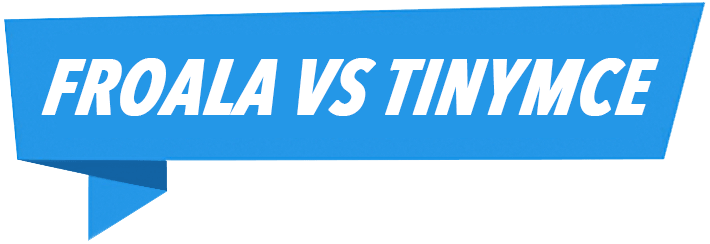- Getting Started
- Browser Support
- Languages Support
- Shortcuts
- Activation
- Examples
- Customize the Editor
- Use-cases
- Plugins
- APIs
- Development Frameworks
- Server Integrations
- Server SDKs
- Migration Guides
- Changelog

Angular and Froala WYSIWYG Editor
For Angular 15+
A newer SDK for Angular 15+ is here.
Angular 1 Plugin
The Angular 1 plugin for the Froala Editor is also available.
Installation instructions
Install
angular-froala-wysiwygfromnpmnpm install angular-froala-wysiwygAdd the CSS styles on your index.html file
<!-- index.html --> <link href="node_modules/froala-editor/css/froala_editor.pkgd.min.css" rel="stylesheet">
Update editor instructions
Run the following command to update the editor:
npm update froala-editor --save
Integration
Use with Angular CLI
Installing @angular/cli
Note: Skip this part if you already generated the application.
npm install -g @angular/cli
ng new my-app
cd my-app
Add angular-froala-wysiwyg
- install
angular-froala-wysiwygnpm install angular-froala-wysiwyg --save open
src/app/app.module.tsand add the following code:// Import Angular plugin. import { FroalaEditorModule, FroalaViewModule } from 'angular-froala-wysiwyg'; ... @NgModule({ ... imports: [FroalaEditorModule.forRoot(), FroalaViewModule.forRoot() ... ], ... })open
angular.jsonfile and insert a new entry into thestylesarray"styles": [ "styles.css", "./node_modules/froala-editor/css/froala_editor.pkgd.min.css", "./node_modules/froala-editor/css/froala_style.min.css", ]in
angular.jsonfile insert a new entry into thescriptsarray"scripts": [ "./node_modules/froala-editor/js/froala_editor.pkgd.min.js" ]open
src/app/app.component.htmland add<div [froalaEditor]>Hello, Froala!</div>
Run angular-cli
ng serve
Use with ionic v2 or v3
Create Ionic app
Note: Skip this part if you already generated the application.
npm install -g cordova ionic
ionic start myApp blank
cd myApp
Add angular-froala-wysiwyg
For v3 make sure that you use the latest version of ionic and also the latest version of angular.
To install Froala Editor in Ionic follow these steps:
Run
bash npm install angular-froala-wysiwyg --saveOpen
src/app/app.module.tsand add:// Import Froala Editor. import "froala-editor/js/froala_editor.pkgd.min.js"; // Import Angular2 plugin. import { FroalaEditorModule, FroalaViewModule } from 'angular-froala-wysiwyg'; ... @NgModule({ ... imports: [FroalaEditorModule.forRoot(), FroalaViewModule.forRoot() ... ], ... })open
src/app/main.tsand addIn
package.jsonadd the following:"config": { "ionic_copy": "./config/copy.config.js" }Run the following commands
mkdir config cp node_modules/@ionic/app-scripts/config/copy.config.js ./config/Open
config/copy.config.jsfile and add the following at the beginning ofmodule.exportsmodule.exports = { copyFroalaEditorCss: { src: ['{{ROOT}}/node_modules/froala-editor/css/froala_editor.pkgd.min.css', '{{ROOT}}/node_modules/froala-editor/css/froala_style.min.css'], dest: '{{BUILD}}' }, ... }Open
src/index.htmlfile and add in the<head>tag:<link rel="stylesheet" href="build/froala_editor.pkgd.min.css"> <link rel="stylesheet" href="build/froala_style.min.css">install
angular-froala-wysiwygnpm install angular-froala-wysiwyg --saveopen
src/app/app.module.tsand add// Import the Froala Editor plugin. import "froala-editor/js/froala_editor.pkgd.min.js"; // Import Angular plugin. import { FroalaEditorModule, FroalaViewModule } from 'angular-froala-wysiwyg'; ... @NgModule({ ... imports: [FroalaEditorModule.forRoot(), FroalaViewModule.forRoot(), ... ], ... })open
src/app/app.component.tsand add to the template<div [froalaEditor]>Hello, Froala!</div>open
config/webpack.common.jsand add the following toCopyWebpackPlugin{ from: 'node_modules/froala-editor/css/', to: 'assets/froala-editor/css/', },open
config/head-config.common.jsand add a new entry to link{ rel: 'stylesheet', href: '/assets/froala-editor/css/froala_editor.pkgd.min.css' }, { rel: 'stylesheet', href: '/assets/froala-editor/css/froala_style.min.css' }install
angular-froala-wysiwygnpm install angular-froala-wysiwyg --saveOpen
tools/config/project.config.tsand uncomment the following line:import { ExtendPackages } from './seed.config.interfaces';Open
tools/config/project.config.tsand add:... this.NPM_DEPENDENCIES = [ ...this.NPM_DEPENDENCIES, { src: 'froala-editor/js/froala_editor.pkgd.min.js', inject: 'libs' }, { src: 'froala-editor/css/froala_editor.pkgd.min.css', inject: true }, { src: 'froala-editor/css/froala_style.min.css', inject: true } ]; ... let additionalPackages: ExtendPackages[] = [ // required for dev build { name:'angular-froala-wysiwyg', path:'node_modules/angular-froala-wysiwyg/bundles/angular-froala-wysiwyg.umd.min.js' }, // required for prod build { name:'angular-froala-wysiwyg/*', path:'node_modules/angular-froala-wysiwyg/bundles/angular-froala-wysiwyg.umd.min.js' } ] this.addPackagesBundles(additionalPackages);Open
src/client/app/home/home.module.tsand add:// Import Angular2 plugin. import { FroalaEditorModule, FroalaViewModule } from 'angular-froala-wysiwyg'; ... @NgModule({ ... imports: [FroalaEditorModule.forRoot(), FroalaViewModule.forRoot() ... ], ... })open
src/client/app/home/home.component.htmland add<div [froalaEditor]>Hello, Froala!</div>install
angular-froala-wysiwygnpm install angular-froala-wysiwyg --saveopen
src/index.htmland add<link rel="stylesheet" href="node_modules/froala-editor/css/froala_editor.pkgd.min.css"> <link rel="stylesheet" href="node_modules/froala-editor/css/froala_style.min.css"> <script src="node_modules/froala-editor/js/froala_editor.pkgd.min.js"></script>Open
src/app/app.module.tsand add:// Import Angular2 plugin. import { FroalaEditorModule, FroalaViewModule } from 'angular-froala-wysiwyg'; ... @NgModule({ ... imports: [FroalaEditorModule.forRoot(), FroalaViewModule.forRoot(), ... ], ... })Open
src/app/app.component.tsand add the following to the template<div [froalaEditor]>Hello, Froala!</div>Open
src/systemjs.config.jsfile and add thefollowing to mapmap: { ... 'angular-froala-wysiwyg': 'npm:angular-froala-wysiwyg/bundles/angular-froala-wysiwyg.umd.js', ... }<div [froalaEditor]>Hello, Froala!</div>Install additional dependencies. Make sure that there is no UNMET PEER DEPENDENCY.
npm install @angular/compiler-cli @angular/platform-server --save npm install rollup rollup-plugin-node-resolve rollup-plugin-commonjs rollup-plugin-uglify --save-dev npm install lite-server --save-devCopy
scr/tsconfig.jsonto a new file calledtsconfig-aot.jsonin the root of the project, then modify it as follows.{ "compilerOptions": { "target": "es5", "module": "es2015", "moduleResolution": "node", "sourceMap": true, "emitDecoratorMetadata": true, "experimentalDecorators": true, "lib": ["es2015", "dom"], "noImplicitAny": true, "suppressImplicitAnyIndexErrors": true, "typeRoots": [ "./node_modules/@types/" ] }, "files": [ "src/app/app.module.ts", "src/main.ts" ], "angularCompilerOptions": { "genDir": "aot", "skipMetadataEmit" : true } }Create a configuration file (
rollup-config.js) in the project root directory to tell Rollup how to process the application.import nodeResolve from 'rollup-plugin-node-resolve'; import commonjs from 'rollup-plugin-commonjs'; import uglify from 'rollup-plugin-uglify'; export default { entry: 'src/main.js', dest: 'src/build.js', // output a single application bundle sourceMap: false, format: 'iife', onwarn: function(warning) { // Skip certain warnings // should intercept ... but doesn't in some rollup versions if ( warning.code === 'THIS_IS_UNDEFINED' ) { return; } // console.warn everything else console.warn( warning.message ); }, plugins: [ nodeResolve({jsnext: true, module: true}), commonjs({ include: 'node_modules/rxjs/**', }), uglify() ] };Update
src/main.tsfile for AOT:import { platformBrowser } from '@angular/platform-browser'; import { AppModuleNgFactory } from '../aot/src/app/app.module.ngfactory'; console.log('Running AOT compiled'); platformBrowser().bootstrapModuleFactory(AppModuleNgFactory);install
angular-froala-wysiwygnpm install angular-froala-wysiwyg --saveopen
src/index.htmland add<link rel="stylesheet" href="node_modules/froala-editor/css/froala_editor.pkgd.min.css"> <link rel="stylesheet" href="node_modules/froala-editor/css/froala_style.min.css"> <script src="node_modules/froala-editor/js/froala_editor.pkgd.min.js"></script>open
src/app/app.module.tsand add// Import Angular2 plugin. import { FroalaEditorModule, FroalaViewModule } from 'angular-froala-wysiwyg'; ... @NgModule({ ... imports: [FroalaEditorModule.forRoot(), FroalaViewModule.forRoot(), ... ], ... })open
src/app/app.component.tsfile and add to the template<div [froalaEditor]>Hello, Froala!</div>open
rollup-config.jsand add the following//paths are relative to the execution path export default { ... plugins: [ ... commonjs({ include: [ 'node_modules/rxjs/**', 'node_modules/angular-froala-wysiwyg/**' ] }), ... ] }
In your desired view add the Froala Editor like this:
<div [froalaEditor]>Hello, Froala!</div>
Run your App
ionic serve
Use with webpack
Create webpack app
Note: Skip this part if you already generated the application.
git clone --depth 1 https://github.com/AngularClass/angular-starter.git
cd angular-starter
npm install
Add angular-froala-wysiwyg
Run the webpack app
npm run start
Use with angular-seed
Create angular-seed app
Note: Skip this part if you already generated the application. For more details refer to: https://github.com/mgechev/angular-seed.
git clone --depth 1 https://github.com/mgechev/angular-seed.git
cd angular-seed
npm install
Add angular-froala-wysiwyg
Run webpack app
npm run start
Use with system.js and JIT
Create Angular app
Note:Skip this part if you already generated the application.
git clone https://github.com/angular/quickstart.git angular-quickstart
cd angular-quickstart
npm install
Add angular-froala-wysiwyg
Run app
npm run start
Use with aot
Create Angular app
Note: Skip this part if you already generated the application.
git clone https://github.com/angular/quickstart.git angular-quickstart
cd angular-quickstart
npm install
Add angular-froala-wysiwyg
Run app
node_modules/.bin/ngc -p tsconfig-aot.json node_modules/.bin/rollup -c rollup-config.js -c rollup-config.js lite-server
Usage
Options
You can pass editor options as Input (optional).
[froalaEditor]='options'
You can pass any existing Froala option. Consult the Froala documentation to view a list available options:
public options: Object = {
placeholderText: 'Edit Your Content Here!',
charCounterCount: false
}
Aditional option is used: * immediateAngularModelUpdate: (default: false). This option synchronizes the angular model as soon as a key is released in the editor. Note that it may affect performance.
Events and Methods
You can pass events with the options, with a key event and object where the key is the event name and the value is the callback function.
public options: Object = {
placeholder: "Edit Me",
events : {
'froalaEditor.focus' : function(e, editor) {
console.log(editor.selection.get());
}
}
}
Using the editor instance from the arguments of the callback you can call editor methods as described in the method docs.
Froala events are described in the events docs.
Model
The WYSIWYG HTML editor content model.
[(froalaModel)]="editorContent"
Pass initial content:
public editorContent: string = 'My Document\'s Title'
Use the content in other places:
<input [ngModel]="editorContent"/>
<input [(ngModel)]="editorContent"/> <!-- For two way binding -->
Other two way binding example:
<div [froalaEditor] [(froalaModel)]="editorContent"></div>
<div [froalaEditor] [(froalaModel)]="editorContent"></div>
Use it with reactive forms:
<form [formGroup]="form" (ngSubmit)="onSubmit()">
<textarea [froalaEditor] formControlName="formModel"></textarea>
<button type="submit">Submit</button>
</form>
If you want to use two-way binding to display the form model in other places you must include [(froalaModel)]:
<form [formGroup]="form" (ngSubmit)="onSubmit()">
<textarea [froalaEditor] formControlName="formModel" [(froalaModel)]="form.formModel"></textarea>
<div [froalaView]="form.formModel"></div>
<button type="submit">Submit</button>
</form>
If you want to wrap froalaEditor directive into a component that supports reactive forms please see https://froala.component.ts from demo.
Extend functionality
You can extend the functionality by adding a custom button like bellow:
// We will make usage of the Init hook and make the implementation there.
import { Component, OnInit } from '@angular/core';
declare var $ :any;
@Component({
selector: 'app-demo',
template: `<div class="sample">
<h2>Sample 11: Add Custom Button</h2>
<div [froalaEditor]="options" [(froalaModel)]="content" ></div>
</div>`,
export class AppComponent implements OnInit{
ngOnInit () {
$.FroalaEditor.DefineIcon('alert', {NAME: 'info'});
$.FroalaEditor.RegisterCommand('alert', {
title: 'Hello',
focus: false,
undo: false,
refreshAfterCallback: false,
callback: () => {
alert('Hello!', this);
}
});
}
public options: Object = {
charCounterCount: true,
toolbarButtons: ['bold', 'italic', 'underline', 'paragraphFormat','alert'],
toolbarButtonsXS: ['bold', 'italic', 'underline', 'paragraphFormat','alert'],
toolbarButtonsSM: ['bold', 'italic', 'underline', 'paragraphFormat','alert'],
toolbarButtonsMD: ['bold', 'italic', 'underline', 'paragraphFormat','alert'],
};
}
Special tags
You can also use the editor on img, button, input and a tags:
<img [froalaEditor] [(froalaModel)]="imgObj"/>
The model must be an object containing the attributes for your special tags. For example:
public imgObj: Object = {
src: 'path/to/image.jpg'
};
The froalaModel will change as the attributes change during usage.
froalaModel can contain a special attribute named innerHTML which inserts innerHTML in the element: If you are using 'button' tag, you can specify the button text like this:
public buttonModel: Object = {
innerHTML: 'Click Me'
};
As the button text is modified by the editor, the innerHTML attribute from buttonModel model will be modified too.
Specific option for special tags
angularIgnoreAttrs: (default: null) This option is an array of attributes that you want to ignore when the editor updates the froalaModel:
public inputOptions: Object = {
angularIgnoreAttrs: ['class', 'id']
};
Manual Initialization
Gets the functionality to operate on the editor: create, destroy and get editor instance. Use it if you want to manually initialize the editor.
(froalaInit)="initialize($event)"
Where initialize is the name of a function in your component which will receive an object with different methods to control the editor initialization process.
public initialize(initControls) {
this.initControls = initControls;
this.deleteAll = function() {
this.initControls.getEditor()('html.set', '');
};
}
The object received by the function will contain the following methods:
initialize: Call this method to initialize the Froala Editor
destroy: Call this method to destroy the Froala Editor
getEditor: Call this method to retrieve the editor that was created. This method will return null if the editor was not yet created
Displaying HTML
To display content created with the froala editor use the froalaView directive.
[froalaView]="editorContent"
<div [froalaEditor] [(froalaModel)]="editorContent"></div>
<div [froalaView]="editorContent"></div>
Do you think we can improve this article? Let us know.


